Thailand Aboard the Ocean Rover, 2004
| Click here to view the 2004 Thailand Photo Gallery |
 |
| Photography by Stephen Frink |
January 2004
Text and Photography by Stephen Frink
||
|---|
|

|
| Stephen Frink|
Oddly enough, our trip to Thailand began in the early 1980s on a boat in the Cocos Islands. One of our guests was a talented underwater photographer named Mark Strickland. This was a "busman's holiday" for Mark and his wife Suzanne, for they worked on a live-aboard dive boat operating out of Phuket in Thailand. The stories they told of their local diving were inspiration enough, but what really set the hook was seeing Mark's images of the region. From the beauty he so artfully captured, we knew someday Thailand had to be a destination worth visiting. What took nearly 20 years? Mostly we were waiting for the right boat. When the Ocean Rover was launched, with Mark as cruise director and on-board UW Photo specialist, we began planning this trip.
Getting There
While I chose to fly Thai International Air from L.A. to Bangkok, and then to Phuket (about 38 hours en route from Miami to touchdown in Phuket), other guests flew China Air, Malaysia Air, or Singapore Air. One of our European guests came directly from Frankfurt to Phuket via Thai Air, so European gateways are viable alternatives as well.
||
|---|
|

|
| Photography by Stephen Frink|
The airfare was quite reasonable as well--only about $850 for the L.A. - Phuket roundtrip portion, but it is a looooong trip for sure. Still, among international destinations, Thailand is among the more accessible and reasonably priced.
In researching this trip I found a good reference in the Lonely Planet Diving & Snorkeling Thailand by Mark Strickland and John Williams.
 |
| Photography by Stephen Frink |
The Ocean Rover Experience
||
|---|
|

|
| Photography by Stephen Frink|
We were met at the airport by Ocean Rover staff holding a sign with our names, always a comfort after a long trip to an unfamiliar destination. Arriving in the mid-day as we did, we had several hours to kill before boarding the boat at 8:00 p.m. that evening, so most of us opted to visit the Evason Phuket Resort and Spa ([email protected]). Several of the guests chose to arrive a few days early and acclimate to the time shift, while others were content merely to have a shower and a nap in a day room. For those with a bit of time to spare and a hedonistic orientation, the spa offers a wide variety of massage options. We found the Evason is a lovely respite from the rigors of travel. Note however, this is a very "vertical" resort, with many steps between most of the guest rooms and the beach and dining areas. It is definitely not a wheelchair accessible resort, except via the available motorized transport from the lobby to the some of the restaurants.
In the late afternoon we were transported to Ocean Rover headquarters near the Chalong Bay Tourist Pier. Here we did the formalities of presenting our passports and paying the $150 cash Port and Park Fee required for the tour into Myanmar. Four passport pictures are also required for Myanmar immigration. By 8:00 p.m. we were checked into our cabins and underway for the 60 nautical mile steam to our first morning's dive.
Day 1
As is the norm for most live-aboards, the first dive is pretty easy. Good for adjusting buoyancy, and given the jet-lag most of us were suffering, a safe call. Yet, Morning Glory provided some nice large seafans decorated with soft coral for the wide angle enthusiasts. There were also plenty of opal sweepers engulfing some of the large bommies, and that brought lionfish hoping for an easy snack. We also saw a frogfish, which generated a bit of a photo frenzy on this first dive. As time went by we discovered frogfish aren't really so rare here, and so became a bit more selective of backgrounds and general composition for our lionfish shots.
||
|---|
|

|
| Photography by Stephen Frink|
At East of Eden opal sweepers were even more densely packed in the coral crevices, making it hard to give up wide angle, despite the sea snake and friendly coral trout that beckoned to the fish photographers. The massive gorgonian down at around 100 feet suggest that current does occasionally sweep this site, but it was calm and clear during our dive.
Hideaway provides a great opportunity to photograph large schools of blue-lined snapper along the reef slope. In fact, I watched one of my buddies work the same school for about 10 minutes, envying his luck with this school, until I moved into the shallows and found an even bigger school commingling with very approachable red-tailed butterflyfish. Coral grouper, regal angelfish, fire lionfish, and long-snout butterflyfish were all very common along the high profile coral heads; while numerous shrimp and gobie combinations occupied those scouring the reef rubble for macro life.
 |
| Photography by Stephen Frink |
Day 2
||
|---|
|

|
| Photography by Stephen Frink|
As calm and uneventful as our first day was, our morning dive at Christmas Point reminded us that current can indeed be a component of Thai dive sites. But those who were able to find a comfortable lee were rewarded three leopard sharks! Seeing one is treat enough, but multiples on any dive is special indeed. Other highlights included the blue-ringed angelfish and ribbon eel. Already our shooters seem to be migrating away from wide angle in favor of 60mm and 105m macro lenses. Not that there isn't plenty of wide angle to shoot here in the Similans, but there is such abundance of rare critters, it is hard to ignore the reef minutia.
The Similans are an extraordinarily scenic string of granite islands rimmed with white sand beaches. Actually some of the structures remind me of Baths in the British Virgin Islands, but with fewer yachts and tourists. Make sure to schedule some time for topside photography while in the Similans for the geography here is different than in Myanmar and throughout the Mergui Archipelago. For pure tropical splendor, the Similans quite unique.
Ko Bon is a pinnacle that only rises to about 40 feet, and minimally offers the soft coral and gorgonian decoration of the other sites. But this site is good for schooling fish like bigeye jack and large clouds of fusiliers. Our visit also netted a rather large white-tip reef shark and the endemic Andaman sweetlips.
The shallow reef at Ko Tachai isn't so great anymore, probably mostly because of carelessly placed anchors from fishing and squid boats. But the submerged Twin Peaks (40 feet to the top) at the south end supports large sea fans, soft corals, and barrel sponge. This is a good place for leopard sharks as well, but the macro shooters remained occupied with porcelain crabs and moray eels.
 |
| Photography by Stephen Frink |
Day 3
||
|---|
|

|
| Photography by Stephen Frink|
A visit to Richelieu Rock will be the highlight of any tour to the Andaman Sea. The rock barely breaks the surface at low tide, and the sand platform is probably only about 105 feet. But in between there are amazing photo-opportunities, including a congregate of about 14 lionfish along the face of east rock, a giant grouper we'd call "Goliath" in our hemisphere (called "Malabar grouper" here), and some of the most approachable coral trout anywhere. Those with an eye for small critters, or better yet, tour in the company of our on-board critter spotters, will find tiger-tail seahorse, ghost pipefish, and a wide variety of nudibranch. Our group was delighted to find mantis shrimp and many, many scorpionfish everywhere. Dense concentrations of sea anemones cloak the shallows, and cuttlefish seem to be a common sighting. In year's past this was prime whale shark country, and of course can still offer the possibility. However, where there might have been 20 encounters per season a decade ago, there were 2 last year. If a whale shark happens by during your visit to Thailand, that is a happy circumstance, but the days are long gone when you could count on it.
We did three dives this day on Richelieu Rock, but then had to weigh anchor to reach the Myanmar border in time to do customs formalities. Actually, there was little for us to do other than sit on the sundeck and sip a beer while customs officials came aboard to make sure our face matched our passport.
Day 4
||
|---|
|

|
| Photography by Stephen Frink|
The Mergui Archipelago covers about 14,000 square miles and includes about 800 islands. Similar in size to the Bahamas, I guess, and apparently some of the islands are quite large and uninhabited. There are reputed to be wild elephants and even tigers on some of the larger, more remote islands.
Many of the islets are close to shore and influenced by outflow from rivers. Those islands that are suitable for diving have not received significant visitation. While it is likely, almost to the point of certainty, that there will be several other boats on any of the sites in the Similans, there is much more of a sense of wilderness dive travel in Mergui. Of course, while it may be unlikely to see another dive boat, it is likely to see small local fishing boats at the same anchorage.
The water clarity may not be stunning, but the sheer quantity and variety of unique marine life makes this a highlight of the Ocean Rover itinerary.
We started our Mergui adventure at Three Islets, consisting of one small island and two large rocks, each far enough apart to be considered separate dive sites. This is ideal for multi-level diving, because even at 15 feet you'll be rewarded with interesting marine life, like this day's mating cuttlefish. The stars of the show are again small creatures like harlequin shrimp, juvenile ribbon eel, seahorse, devil scorpionfish and both fimbriated and jeweled morays, most often occupying the very same hole. Despite the marginal visibility, large schools of fish and immense sea fans invited wide-angle, given the variety of enticing marine life concentrated in such a small area, any small area, 60mm and 105mm macros got their workouts today.
We did four dives during the day here (as well as an optional night dive, as is common at most of our evening anchorages), so everyone really learned where the best critters were and could revisit at leisure with the right lens. This is a great luxury, available only to live-aboard photo enthusiasts.
 |
| Photography by Stephen Frink |
Day 5
||
|---|
|

|
| Photography by Stephen Frink|
This morning found us anchored in proximity to McCarthy Island, a massive monolith with minimal decoration from the surface down to about 25 feet. Here there began modest soft coral and gorgonian concentrations, and while the structure might invite wide angle, the real attraction is small critters. In one small area there were 18 Roboasta arika nudibranchs, as well as some larger marine life like blue-ring angelfish, lionfish, scorpionfish, juvenile white-collar butterflyfish, and Jenkins whiprays.
Note: If you don't already have it, pick up a copy of Reef Fish Identification - Tropical Pacific by Gerald Allen, Roger Steen, Paul Human, and Ned DeLoach. So many of the creatures you will see in Thai/Burmese waters are so unusual, you'll need a comprehensive reference like this to identify your new critter sightings.
At our next dive was at Bang Bang Buffet, so named for all the tank-banging that goes on among the guests eager to show their dive buddy whatever new critter they'd observed. The bottom revealed many of the usual suspects, including cuttlefish, longsnout pipefish, black-blotched moray, and of course lionfish. But the real stars, if something this small can get marquee billing, were nudibranchs. Rare rabbit-ear nudibranch were abundant, as were numerous other species. Not being a nudibranch kind of guy I was amused at all the Latin being tossed at these tiny sea slugs between dives, and the time spent in the marine reference library just trying to determine which of the two dozen species our divers might have seen on this dive.
Day 6
||
|---|
|

|
| Photography by Stephen Frink|
Andy's Pinnacles is a new addition to the Ocean Rover itinerary. Named for our local dive guide and critter-spotter extraordinaire, Andy's Pinnacles is not a multi-level dive like many we've done, but rather is a deep pinnacle topping out at about 65 feet. There is very nice soft coral and generally colorful decoration along the rocky substrate, but diving it in the early morning made ambient light a challenge for wide angle. Still, the visibility was unusually good today, about 60 feet. Schooling batfish were sighted, as well as lionfish, jacks, fusiliers, and plenty of red-bar anthias.
Western Rocky is a series of monolithic rocks punctuating today's slick calm sea. Like many of the islands we've dived in Mergui, the top 20 feet is pretty barren, but there are caves and ledges rich with orange cup corals, barnacles, and some smallish sea fans. The stars this day were mating cuttlefish, a large octopus, and numerous finbriated morays. It was interesting to watch the golden wentletrap snails extend their proboscis into the mouths of the tubastrea corals to vacuum their innards for their mid-day snack. Well, maybe not so interesting to the tubastrea.
One of the nice things about the luxury of repeat dives on the same site on a live-aboard is the ability to go back and reshoot the hot set-ups. Seeing the mating cuttlefish on the laptops of our digital shooters at our lunch break assured a photo frenzy on the same subjects next dive. Those with the discipline to go elsewhere, or perhaps the impatience to outwait the queue, were rewarded with clawed reef lobster, blue-ringed angelfish, red emperor snapper, and stingrays along the sand bottom at about 110 feet.
This night we cleared customs back into Myanmar and had a chance to do a bit of shopping in the small, rustic boutiques of Kaw Thong (Victoria Point). Lacquered woodcraft, carved elephants (for good luck, always with the trunk pointing up), and miscellaneous knick-knacks satisfied the shopping imperative of those recently deprived.
 |
| Photography by Stephen Frink |
Day 7
||
|---|
|

|
| Photography by Stephen Frink|
This morning brings us back to Richelieu Rock, gratefully with stunning visibility. With 120 foot water clarity, even the pre-breakfast dive presents wide-angle opportunities with scores of anemone colonies clustered in the shallows, as well as schools of snapper at depth. The congregation of lionfish on the eastern pinnacle remained a popular sighting, as did the coral grouper along the sea fans at about 100 feet. No big stuff today, but the scorpionfish in the green turtle grass, tigertail seahorse, and the harlequin ghost pipefish were consistent attractions for the critter enthusiasts. The schedule called for two dives at Richelieu, but it was only with great reluctance we left the amazing visibility here this day.
A three hour steam brought us to the furthest inshore of the sites on our itinerary, the wreck of the 160-foot tin dredge Kao Lak. Predictably, this also gave us the most marginal visibility we'd had so far, maybe 40 foot. However, the ship isn't much more than a big box with some deck machinery, so seeing the "big picture" was not as important as observing the smaller creatures here. There are loads of lionfish and large clusters of porcupinefish. In the sand there were ample goby/shrimp symbiants (if there isn't such a word, there needs to be), flatheads (close cousins to crocodilefish), juvenile bannerfish, and schooling squid.
During the surface interval we saw the most exciting marine life interaction of the day as a marlin had its way with a school of baitfish. It was only 10 yards to port, but by the time any of us got in for a look the action had moved away. We should have tried sooner, but it was fun to watch from the surface. Or maybe it was Mark's stories from earlier in the week about one of their guests who had actually been speared by a marlin in an encounter just such as this that gave us pause. At any rate, we were plenty content with simply scuba diving on and around this productive wreck site.
 |
| Photography by Stephen Frink |
Day 8
||
|---|
|

|
| Photography by Stephen Frink|
Back in the Similans we are a little disappointed to find our visibility is less than earlier in the week. We had been so pleasantly surprised in Myanmar we thought our luck would hold, especially since many of us now need a dose of wide angle after so much muck and macro life. Actually, close focus wide angle remains fairly productive but the sweeping vistas aren't available to us this day. At Elephant's Head we had 30 to 40 foot visibility, but good encounters with Andaman sweetlips, giant trevally, octopus, and a hawksbill turtle. At depth there were purple dart gobies, and in the shallows along the rock face were countless blennies occupying vacant barnacle shells.
Now working our way back to Phuket we have the opportunity to revisit some of our favorite sites from earlier in the week. East of Eden was our second dive this day, and predictably still demonstrated fine wide angle along the deep reef at about 100 feet, as well as nice concentrations of soft corals, sea fans, and opal sweepers along a prominent bommy rising to within 20 feet of the surface. At Christmas Point the highlight was a blue ribbon eel, significant because although we'd seen plenty of the black juveniles this trip, this was the first of the more vibrant blue-and-yellow adults. Hideaway was good for its many blue-spotted rays along the sand bottom, a pair of octopus, and of course the leopard sharks most probably seen here.
Day 9
Today we'll get in three dives, encores of those visited earlier in the week, and then pack our gear during the long steam back to Phuket. In retrospect, this has been a great dive experience on a world-class live-aboard. The service has been exemplary and the diving diverse and productive. The islands were beautiful as well, and time should be scheduled from a busy dive itinerary to walk on their powdery white expanse. There may be better places for clear water and soft coral, but the unique marine life is a huge draw for this destination. The combination of safe, friendly, exotic Thailand and the professionalism of the Ocean Rover deserves consideration for anyone who loves live-aboard dive travel.
Photo Brief & Tips from Stephen Frink
||
|---|
|

|
| Photography by Stephen Frink|
This is typical of the kinds of subject matter you might find in warm-water Indo-Pacific destinations, with the addition of some unusual critters both at the macro and wide-angle end of the spectrum. To that end, you will need a pretty complete photographic arsenal.
Topside - For topside photo enthusiasts, the islands are beautiful, with white sand beaches and dramatic granite rock formations contrasting with beautifully clear aquamarine water. So I see this as wide angle opportunities, with some over/under thrown in. Note however that the "under" portion next to the islands is typically just sand or boulders rather than scenic coral reef. Those shooting Nikon digitals will want their 12-24 zoom, and probably a 24-120. I doubt there will be much in the way of super telephoto subjects. Film shooters, or anyone with a full frame digital sensor, will want a superwide in the 14/15mm range, a wide zoom like the Canon 17-40mm or Nikon 17-35, and a moderate telephoto zoom as well.
Underwater Wide - The soft corals and abundant marine life along the coral reefs suggest wide-angle, especially as there is always the chance of finding a whale shark or silvertip. For Nikonos shooters, the 15mm is your "go-to" lens. Housings with the 12-24 digital, or anything in the 17 to 20mm range should be very useful. RS shooters will no doubt enjoy their 13mm, 28mm, or 20-35mm zoom lenses.
Underwater Macro - Housing shooters will find plenty of subject matter for their 60 and 105mm macro lenses, in fact this is one of the prime attractions of this cruise. Yes, there is plenty of clear water and soft coral, but the wealth of small and unusual marine life is impressive. The crew is experienced spotters, and their trained eye will help reveal some dramatic macro life along these reefs. RS enthusiasts will want their 50mm macro at the ready, and Nikonos shooters will find ample subject matter for their close-up kits and extension tubes. Whether the critters will hold still long enough to capture them with the wire framer I can't guarantee, but no doubt the subjects will be there.
There is E-6 film processing aboard. 110 and 220 volt outlets are available for charging strobes and other batteries.
Digital shooters should prepare with a couple of 1 - 2GB memory cards and the ability to download onto a laptop, external hard drive, or CD/DVD burner. Film enthusiasts should prepare for up to 5 dives a day for 9 days. That can easily be 100 rolls of film for the week, or 200 rolls for the shooters who booked back-to-back trips with us. At a minimum of $15 per roll for combination film and processing, anyone shooting 200 rolls of film might want to consider investing that $3,000 in a digital camera system, but that's a different story for another time. My favorite film remains Fujichrome Velvia, in both 50 and 100 ISO versions. But the color rendered by the Kodak 100 VS is quite nice. If you haven't tried it yet, visit www.kodak.com.
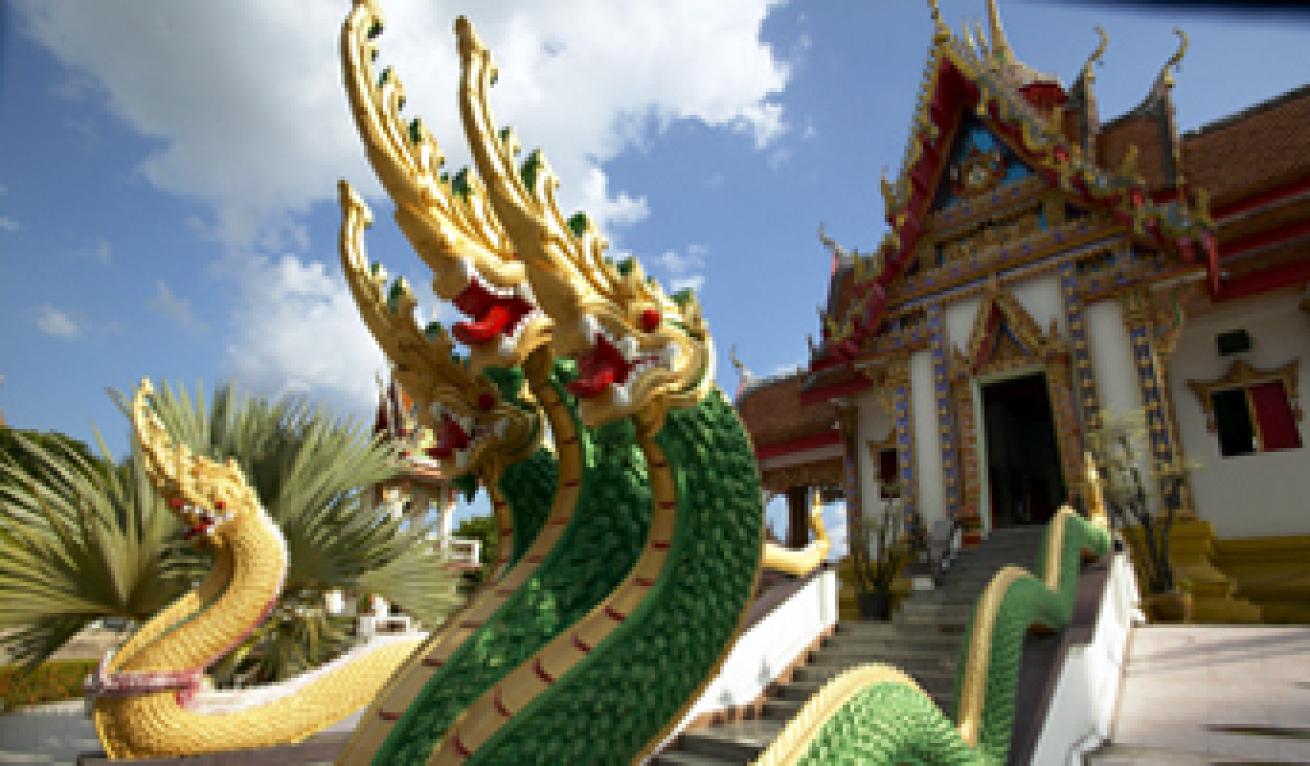
January 2004
Text and Photography by Stephen Frink

| | Stephen Frink| Oddly enough, our trip to Thailand began in the early 1980s on a boat in the Cocos Islands. One of our guests was a talented underwater photographer named Mark Strickland. This was a "busman's holiday" for Mark and his wife Suzanne, for they worked on a live-aboard dive boat operating out of Phuket in Thailand. The stories they told of their local diving were inspiration enough, but what really set the hook was seeing Mark's images of the region. From the beauty he so artfully captured, we knew someday Thailand had to be a destination worth visiting. What took nearly 20 years? Mostly we were waiting for the right boat. When the Ocean Rover was launched, with Mark as cruise director and on-board UW Photo specialist, we began planning this trip.
Getting There
While I chose to fly Thai International Air from L.A. to Bangkok, and then to Phuket (about 38 hours en route from Miami to touchdown in Phuket), other guests flew China Air, Malaysia Air, or Singapore Air. One of our European guests came directly from Frankfurt to Phuket via Thai Air, so European gateways are viable alternatives as well.

Photography by Stephen Frink The airfare was quite reasonable as well--only about $850 for the L.A. - Phuket roundtrip portion, but it is a looooong trip for sure. Still, among international destinations, Thailand is among the more accessible and reasonably priced.
In researching this trip I found a good reference in the Lonely Planet Diving & Snorkeling Thailand by Mark Strickland and John Williams.
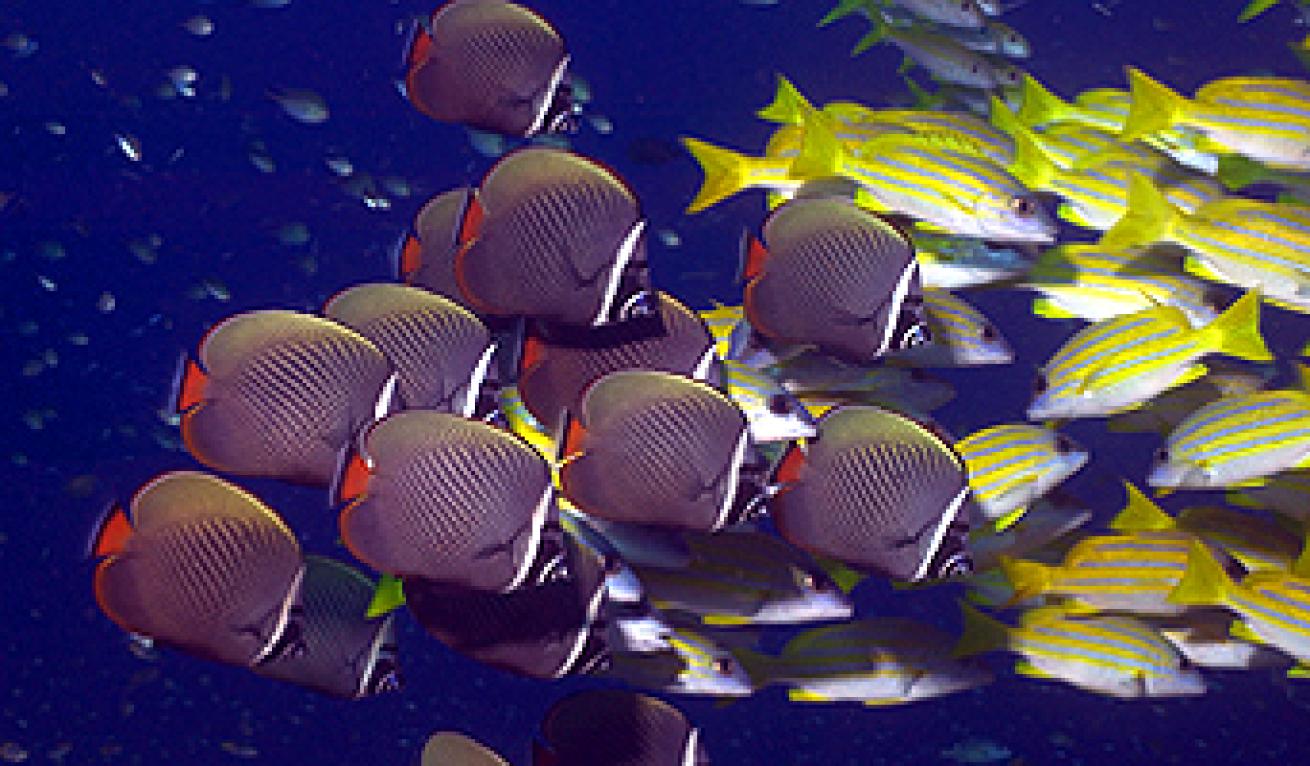
| | Photography by Stephen Frink|
The Ocean Rover Experience
|| |---|
|
| | Photography by Stephen Frink| We were met at the airport by Ocean Rover staff holding a sign with our names, always a comfort after a long trip to an unfamiliar destination. Arriving in the mid-day as we did, we had several hours to kill before boarding the boat at 8:00 p.m. that evening, so most of us opted to visit the Evason Phuket Resort and Spa ([email protected]). Several of the guests chose to arrive a few days early and acclimate to the time shift, while others were content merely to have a shower and a nap in a day room. For those with a bit of time to spare and a hedonistic orientation, the spa offers a wide variety of massage options. We found the Evason is a lovely respite from the rigors of travel. Note however, this is a very "vertical" resort, with many steps between most of the guest rooms and the beach and dining areas. It is definitely not a wheelchair accessible resort, except via the available motorized transport from the lobby to the some of the restaurants.
In the late afternoon we were transported to Ocean Rover headquarters near the Chalong Bay Tourist Pier. Here we did the formalities of presenting our passports and paying the $150 cash Port and Park Fee required for the tour into Myanmar. Four passport pictures are also required for Myanmar immigration. By 8:00 p.m. we were checked into our cabins and underway for the 60 nautical mile steam to our first morning's dive.
Day 1
As is the norm for most live-aboards, the first dive is pretty easy. Good for adjusting buoyancy, and given the jet-lag most of us were suffering, a safe call. Yet, Morning Glory provided some nice large seafans decorated with soft coral for the wide angle enthusiasts. There were also plenty of opal sweepers engulfing some of the large bommies, and that brought lionfish hoping for an easy snack. We also saw a frogfish, which generated a bit of a photo frenzy on this first dive. As time went by we discovered frogfish aren't really so rare here, and so became a bit more selective of backgrounds and general composition for our lionfish shots.
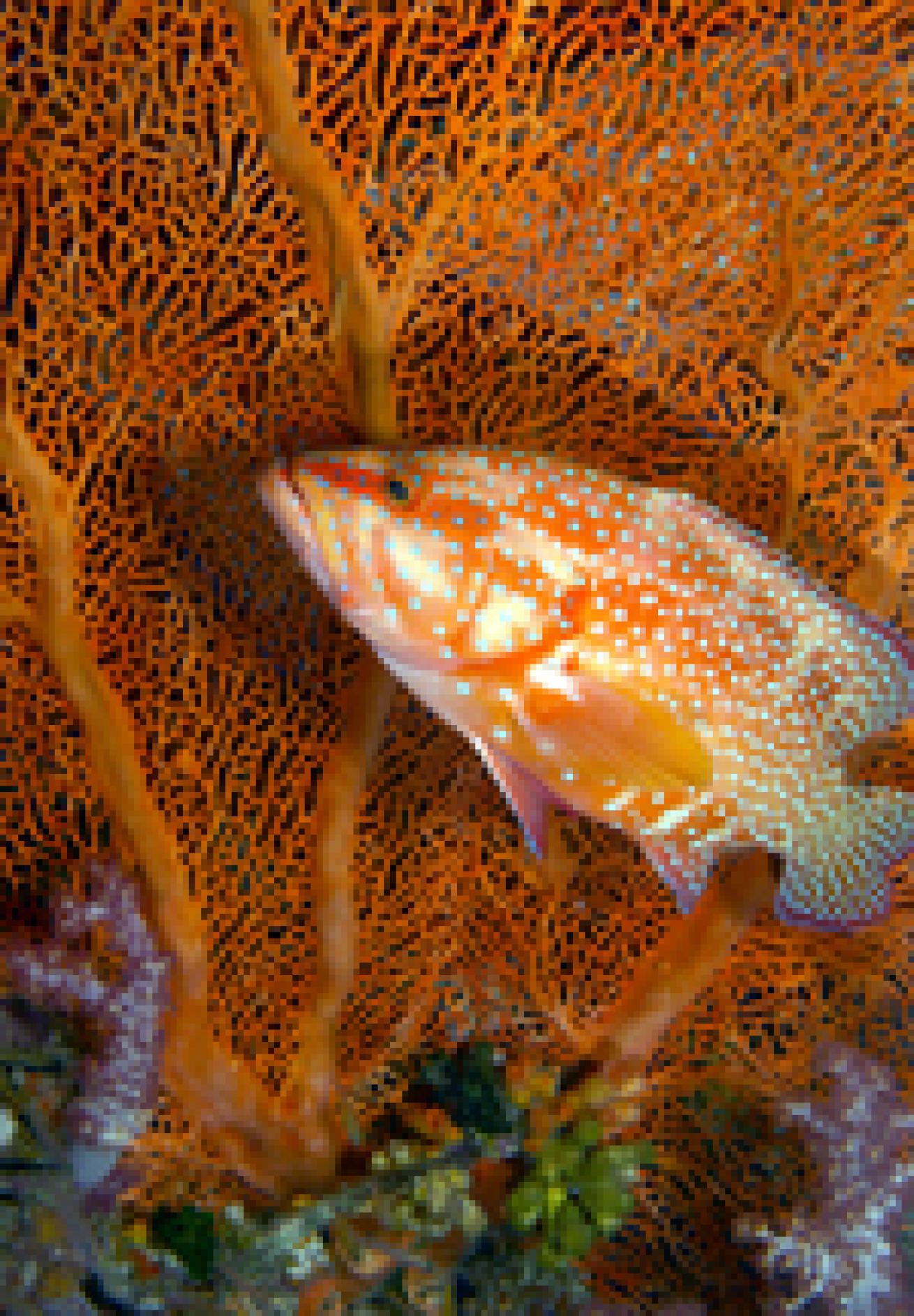
Photography by Stephen Frink At East of Eden opal sweepers were even more densely packed in the coral crevices, making it hard to give up wide angle, despite the sea snake and friendly coral trout that beckoned to the fish photographers. The massive gorgonian down at around 100 feet suggest that current does occasionally sweep this site, but it was calm and clear during our dive.
Hideaway provides a great opportunity to photograph large schools of blue-lined snapper along the reef slope. In fact, I watched one of my buddies work the same school for about 10 minutes, envying his luck with this school, until I moved into the shallows and found an even bigger school commingling with very approachable red-tailed butterflyfish. Coral grouper, regal angelfish, fire lionfish, and long-snout butterflyfish were all very common along the high profile coral heads; while numerous shrimp and gobie combinations occupied those scouring the reef rubble for macro life.
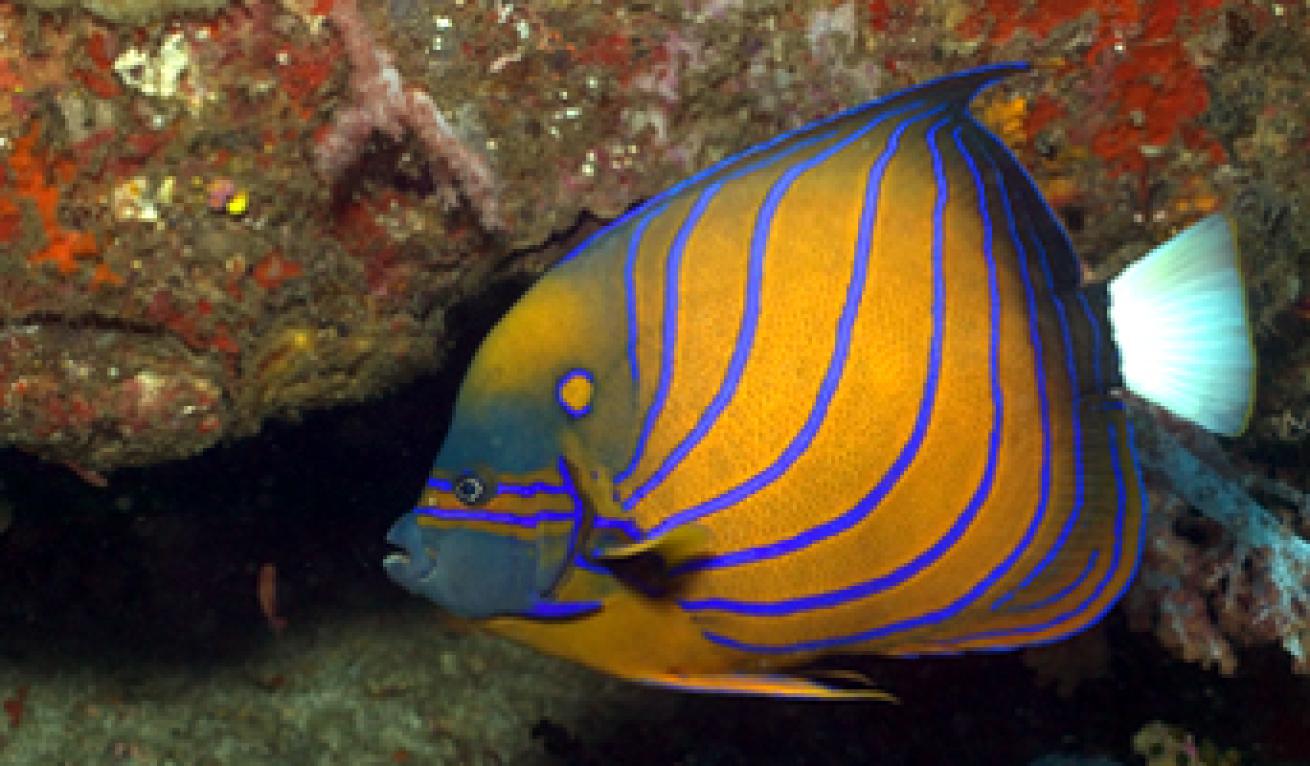
Photography by Stephen Frink
Day 2

Photography by Stephen Frink As calm and uneventful as our first day was, our morning dive at Christmas Point reminded us that current can indeed be a component of Thai dive sites. But those who were able to find a comfortable lee were rewarded three leopard sharks! Seeing one is treat enough, but multiples on any dive is special indeed. Other highlights included the blue-ringed angelfish and ribbon eel. Already our shooters seem to be migrating away from wide angle in favor of 60mm and 105m macro lenses. Not that there isn't plenty of wide angle to shoot here in the Similans, but there is such abundance of rare critters, it is hard to ignore the reef minutia.
The Similans are an extraordinarily scenic string of granite islands rimmed with white sand beaches. Actually some of the structures remind me of Baths in the British Virgin Islands, but with fewer yachts and tourists. Make sure to schedule some time for topside photography while in the Similans for the geography here is different than in Myanmar and throughout the Mergui Archipelago. For pure tropical splendor, the Similans quite unique.
Ko Bon is a pinnacle that only rises to about 40 feet, and minimally offers the soft coral and gorgonian decoration of the other sites. But this site is good for schooling fish like bigeye jack and large clouds of fusiliers. Our visit also netted a rather large white-tip reef shark and the endemic Andaman sweetlips.
The shallow reef at Ko Tachai isn't so great anymore, probably mostly because of carelessly placed anchors from fishing and squid boats. But the submerged Twin Peaks (40 feet to the top) at the south end supports large sea fans, soft corals, and barrel sponge. This is a good place for leopard sharks as well, but the macro shooters remained occupied with porcelain crabs and moray eels.

Photography by Stephen Frink
Day 3
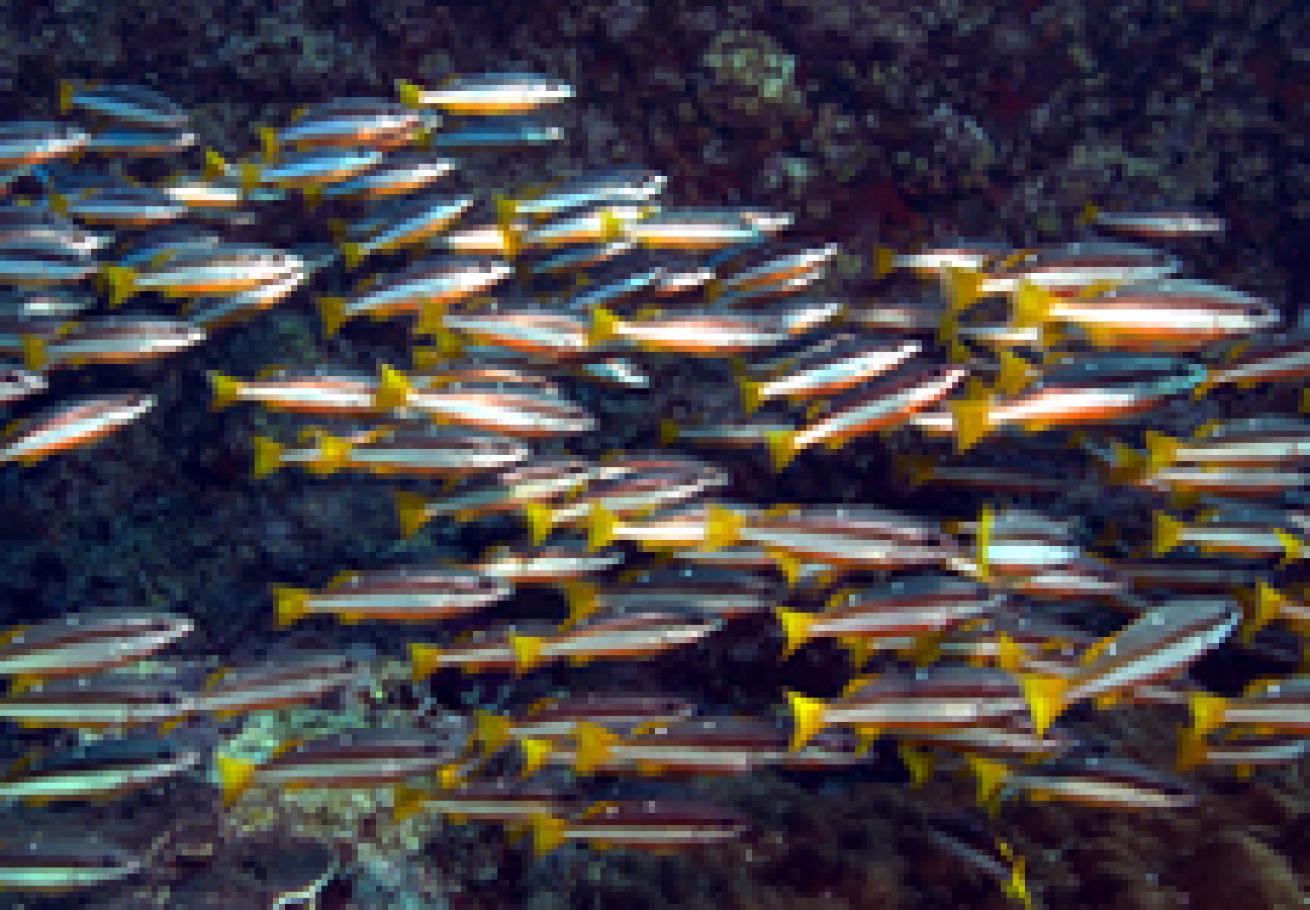
| | Photography by Stephen Frink| A visit to Richelieu Rock will be the highlight of any tour to the Andaman Sea. The rock barely breaks the surface at low tide, and the sand platform is probably only about 105 feet. But in between there are amazing photo-opportunities, including a congregate of about 14 lionfish along the face of east rock, a giant grouper we'd call "Goliath" in our hemisphere (called "Malabar grouper" here), and some of the most approachable coral trout anywhere. Those with an eye for small critters, or better yet, tour in the company of our on-board critter spotters, will find tiger-tail seahorse, ghost pipefish, and a wide variety of nudibranch. Our group was delighted to find mantis shrimp and many, many scorpionfish everywhere. Dense concentrations of sea anemones cloak the shallows, and cuttlefish seem to be a common sighting. In year's past this was prime whale shark country, and of course can still offer the possibility. However, where there might have been 20 encounters per season a decade ago, there were 2 last year. If a whale shark happens by during your visit to Thailand, that is a happy circumstance, but the days are long gone when you could count on it.
We did three dives this day on Richelieu Rock, but then had to weigh anchor to reach the Myanmar border in time to do customs formalities. Actually, there was little for us to do other than sit on the sundeck and sip a beer while customs officials came aboard to make sure our face matched our passport.
Day 4

| | Photography by Stephen Frink| The Mergui Archipelago covers about 14,000 square miles and includes about 800 islands. Similar in size to the Bahamas, I guess, and apparently some of the islands are quite large and uninhabited. There are reputed to be wild elephants and even tigers on some of the larger, more remote islands.
Many of the islets are close to shore and influenced by outflow from rivers. Those islands that are suitable for diving have not received significant visitation. While it is likely, almost to the point of certainty, that there will be several other boats on any of the sites in the Similans, there is much more of a sense of wilderness dive travel in Mergui. Of course, while it may be unlikely to see another dive boat, it is likely to see small local fishing boats at the same anchorage.
The water clarity may not be stunning, but the sheer quantity and variety of unique marine life makes this a highlight of the Ocean Rover itinerary.
We started our Mergui adventure at Three Islets, consisting of one small island and two large rocks, each far enough apart to be considered separate dive sites. This is ideal for multi-level diving, because even at 15 feet you'll be rewarded with interesting marine life, like this day's mating cuttlefish. The stars of the show are again small creatures like harlequin shrimp, juvenile ribbon eel, seahorse, devil scorpionfish and both fimbriated and jeweled morays, most often occupying the very same hole. Despite the marginal visibility, large schools of fish and immense sea fans invited wide-angle, given the variety of enticing marine life concentrated in such a small area, any small area, 60mm and 105mm macros got their workouts today.
We did four dives during the day here (as well as an optional night dive, as is common at most of our evening anchorages), so everyone really learned where the best critters were and could revisit at leisure with the right lens. This is a great luxury, available only to live-aboard photo enthusiasts.

| | Photography by Stephen Frink|
Day 5
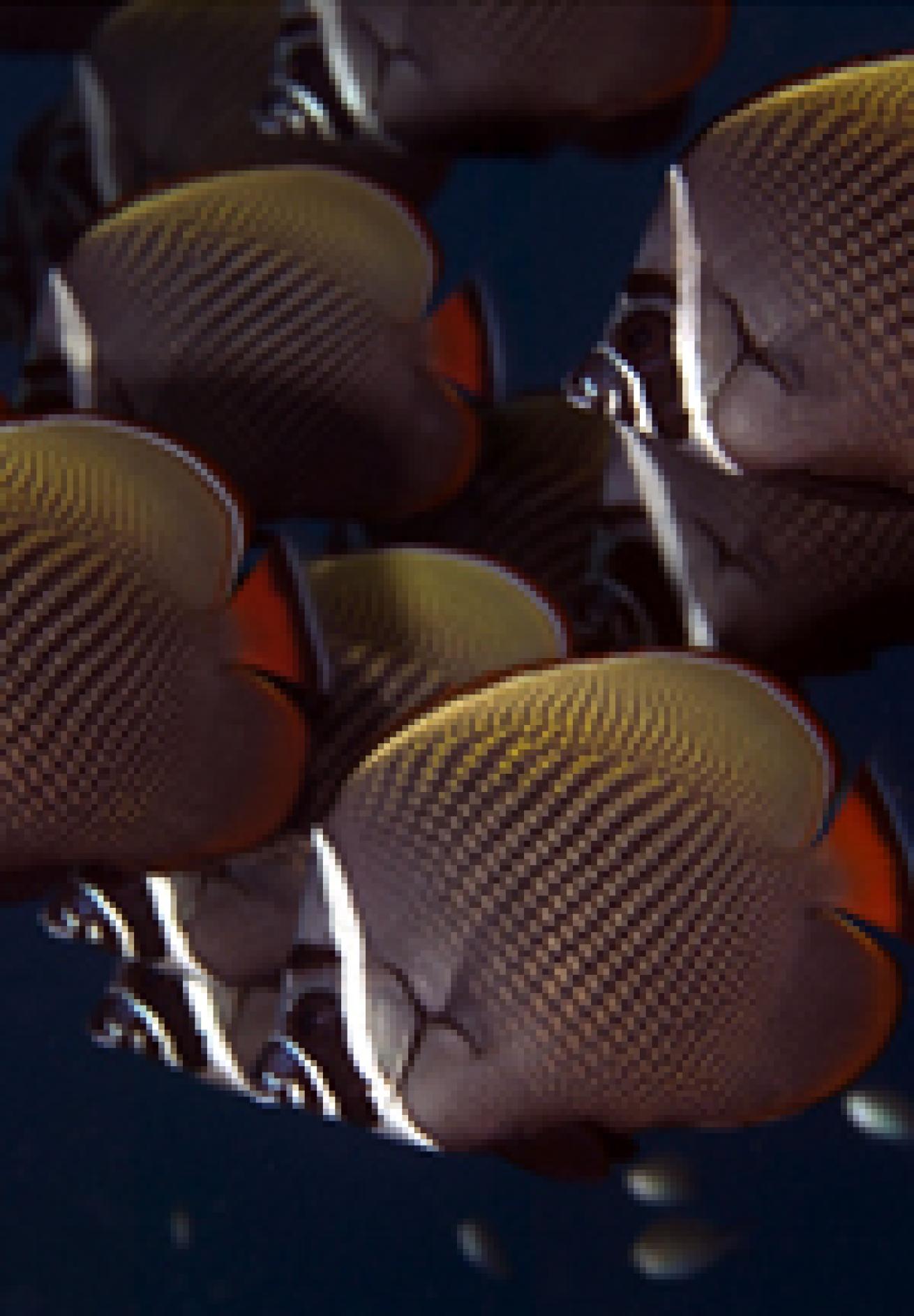
| | Photography by Stephen Frink|
Note: If you don't already have it, pick up a copy of Reef Fish Identification - Tropical Pacific by Gerald Allen, Roger Steen, Paul Human, and Ned DeLoach. So many of the creatures you will see in Thai/Burmese waters are so unusual, you'll need a comprehensive reference like this to identify your new critter sightings.
At our next dive was at Bang Bang Buffet, so named for all the tank-banging that goes on among the guests eager to show their dive buddy whatever new critter they'd observed. The bottom revealed many of the usual suspects, including cuttlefish, longsnout pipefish, black-blotched moray, and of course lionfish. But the real stars, if something this small can get marquee billing, were nudibranchs. Rare rabbit-ear nudibranch were abundant, as were numerous other species. Not being a nudibranch kind of guy I was amused at all the Latin being tossed at these tiny sea slugs between dives, and the time spent in the marine reference library just trying to determine which of the two dozen species our divers might have seen on this dive.
Day 6
|| |---|
|
| | Photography by Stephen Frink| Andy's Pinnacles is a new addition to the Ocean Rover itinerary. Named for our local dive guide and critter-spotter extraordinaire, Andy's Pinnacles is not a multi-level dive like many we've done, but rather is a deep pinnacle topping out at about 65 feet. There is very nice soft coral and generally colorful decoration along the rocky substrate, but diving it in the early morning made ambient light a challenge for wide angle. Still, the visibility was unusually good today, about 60 feet. Schooling batfish were sighted, as well as lionfish, jacks, fusiliers, and plenty of red-bar anthias.
Western Rocky is a series of monolithic rocks punctuating today's slick calm sea. Like many of the islands we've dived in Mergui, the top 20 feet is pretty barren, but there are caves and ledges rich with orange cup corals, barnacles, and some smallish sea fans. The stars this day were mating cuttlefish, a large octopus, and numerous finbriated morays. It was interesting to watch the golden wentletrap snails extend their proboscis into the mouths of the tubastrea corals to vacuum their innards for their mid-day snack. Well, maybe not so interesting to the tubastrea.
One of the nice things about the luxury of repeat dives on the same site on a live-aboard is the ability to go back and reshoot the hot set-ups. Seeing the mating cuttlefish on the laptops of our digital shooters at our lunch break assured a photo frenzy on the same subjects next dive. Those with the discipline to go elsewhere, or perhaps the impatience to outwait the queue, were rewarded with clawed reef lobster, blue-ringed angelfish, red emperor snapper, and stingrays along the sand bottom at about 110 feet.
This night we cleared customs back into Myanmar and had a chance to do a bit of shopping in the small, rustic boutiques of Kaw Thong (Victoria Point). Lacquered woodcraft, carved elephants (for good luck, always with the trunk pointing up), and miscellaneous knick-knacks satisfied the shopping imperative of those recently deprived.
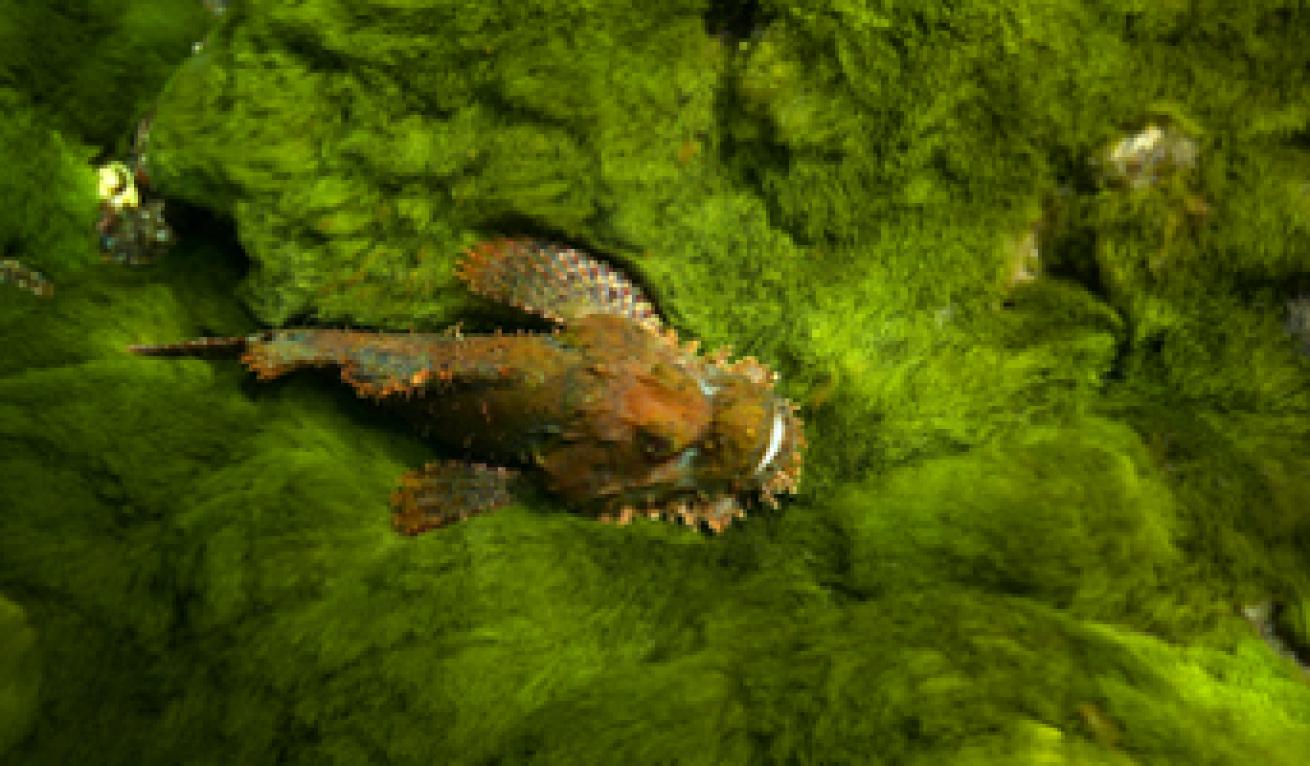
| | Photography by Stephen Frink|
Day 7

| | Photography by Stephen Frink| This morning brings us back to Richelieu Rock, gratefully with stunning visibility. With 120 foot water clarity, even the pre-breakfast dive presents wide-angle opportunities with scores of anemone colonies clustered in the shallows, as well as schools of snapper at depth. The congregation of lionfish on the eastern pinnacle remained a popular sighting, as did the coral grouper along the sea fans at about 100 feet. No big stuff today, but the scorpionfish in the green turtle grass, tigertail seahorse, and the harlequin ghost pipefish were consistent attractions for the critter enthusiasts. The schedule called for two dives at Richelieu, but it was only with great reluctance we left the amazing visibility here this day.
A three hour steam brought us to the furthest inshore of the sites on our itinerary, the wreck of the 160-foot tin dredge Kao Lak. Predictably, this also gave us the most marginal visibility we'd had so far, maybe 40 foot. However, the ship isn't much more than a big box with some deck machinery, so seeing the "big picture" was not as important as observing the smaller creatures here. There are loads of lionfish and large clusters of porcupinefish. In the sand there were ample goby/shrimp symbiants (if there isn't such a word, there needs to be), flatheads (close cousins to crocodilefish), juvenile bannerfish, and schooling squid.
During the surface interval we saw the most exciting marine life interaction of the day as a marlin had its way with a school of baitfish. It was only 10 yards to port, but by the time any of us got in for a look the action had moved away. We should have tried sooner, but it was fun to watch from the surface. Or maybe it was Mark's stories from earlier in the week about one of their guests who had actually been speared by a marlin in an encounter just such as this that gave us pause. At any rate, we were plenty content with simply scuba diving on and around this productive wreck site.
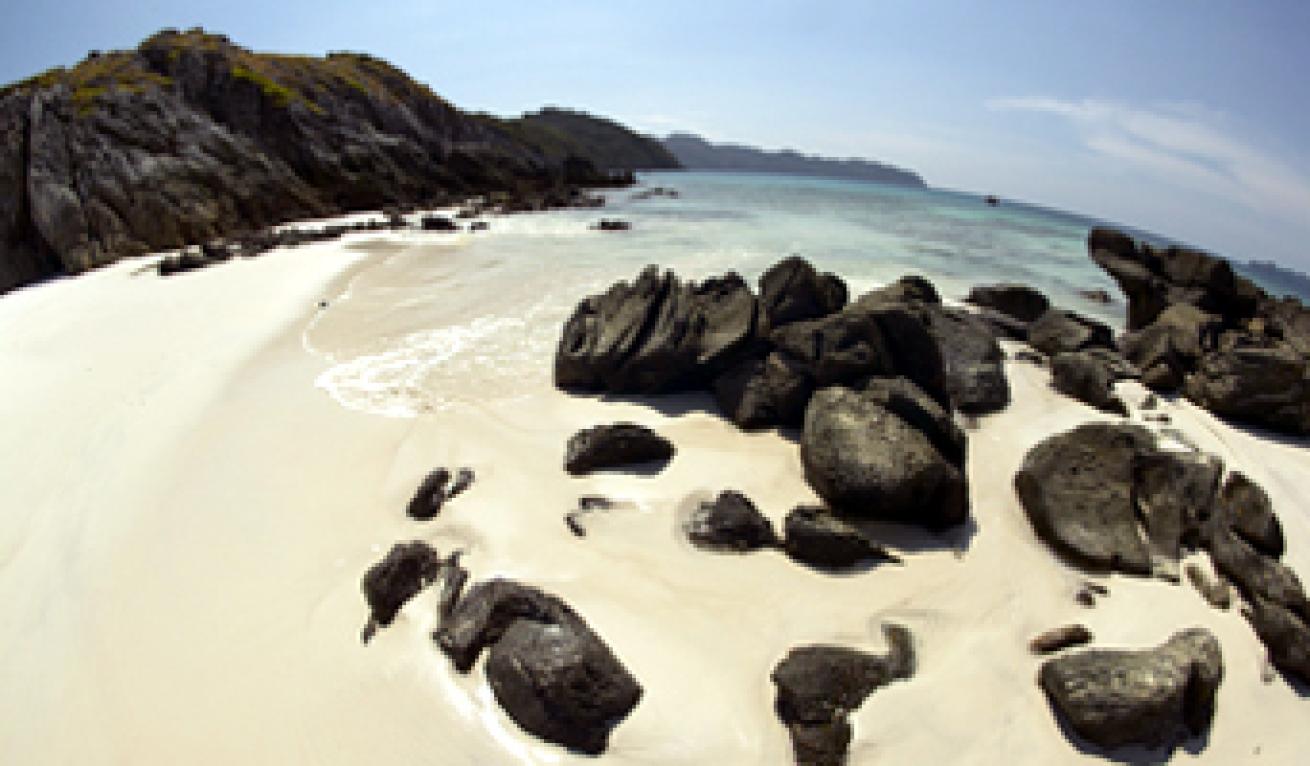
Photography by Stephen Frink
Day 8
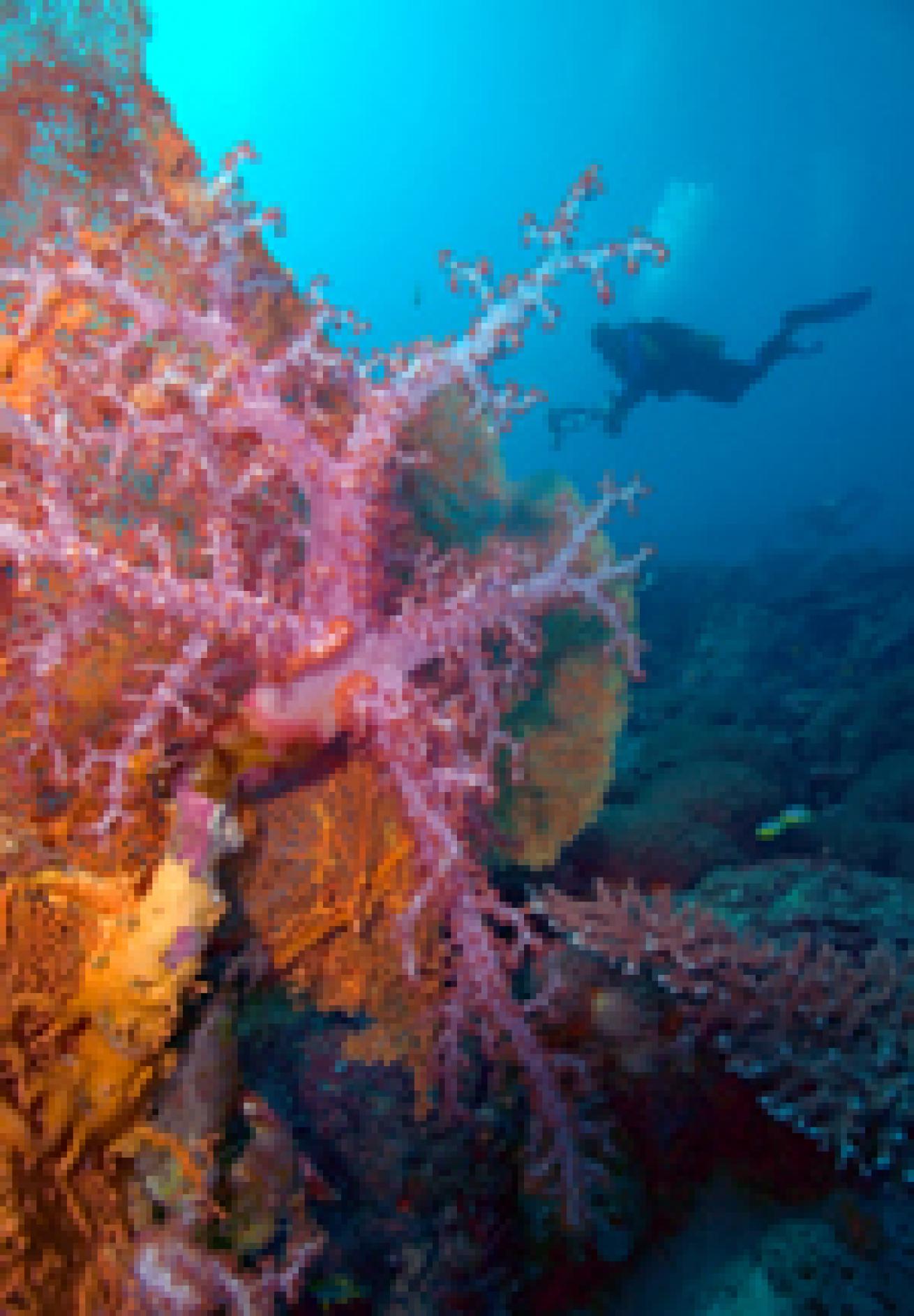
| | Photography by Stephen Frink|
Now working our way back to Phuket we have the opportunity to revisit some of our favorite sites from earlier in the week. East of Eden was our second dive this day, and predictably still demonstrated fine wide angle along the deep reef at about 100 feet, as well as nice concentrations of soft corals, sea fans, and opal sweepers along a prominent bommy rising to within 20 feet of the surface. At Christmas Point the highlight was a blue ribbon eel, significant because although we'd seen plenty of the black juveniles this trip, this was the first of the more vibrant blue-and-yellow adults. Hideaway was good for its many blue-spotted rays along the sand bottom, a pair of octopus, and of course the leopard sharks most probably seen here.
Day 9
Today we'll get in three dives, encores of those visited earlier in the week, and then pack our gear during the long steam back to Phuket. In retrospect, this has been a great dive experience on a world-class live-aboard. The service has been exemplary and the diving diverse and productive. The islands were beautiful as well, and time should be scheduled from a busy dive itinerary to walk on their powdery white expanse. There may be better places for clear water and soft coral, but the unique marine life is a huge draw for this destination. The combination of safe, friendly, exotic Thailand and the professionalism of the Ocean Rover deserves consideration for anyone who loves live-aboard dive travel.
Photo Brief & Tips from Stephen Frink
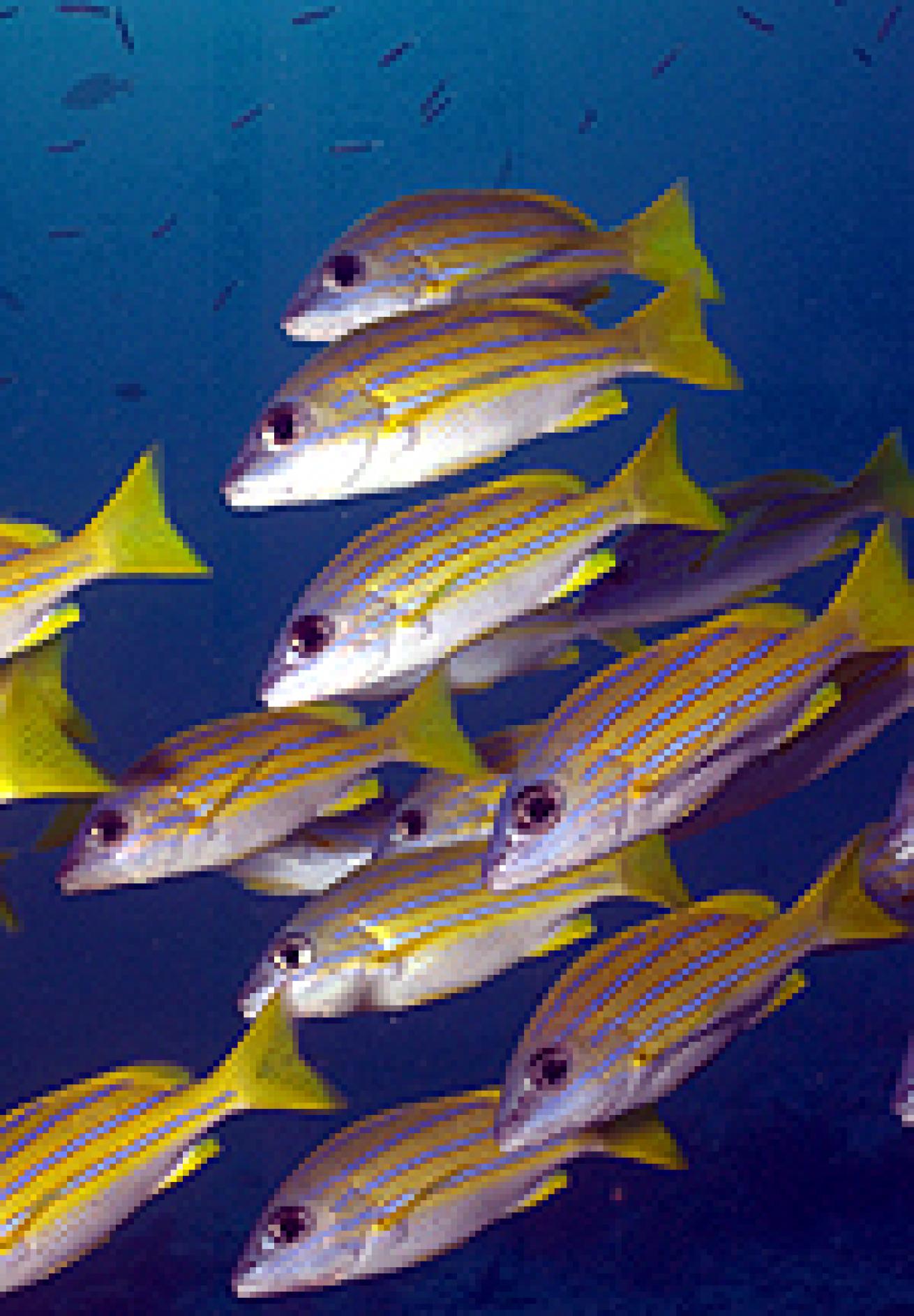
| | Photography by Stephen Frink| This is typical of the kinds of subject matter you might find in warm-water Indo-Pacific destinations, with the addition of some unusual critters both at the macro and wide-angle end of the spectrum. To that end, you will need a pretty complete photographic arsenal.
Topside - For topside photo enthusiasts, the islands are beautiful, with white sand beaches and dramatic granite rock formations contrasting with beautifully clear aquamarine water. So I see this as wide angle opportunities, with some over/under thrown in. Note however that the "under" portion next to the islands is typically just sand or boulders rather than scenic coral reef. Those shooting Nikon digitals will want their 12-24 zoom, and probably a 24-120. I doubt there will be much in the way of super telephoto subjects. Film shooters, or anyone with a full frame digital sensor, will want a superwide in the 14/15mm range, a wide zoom like the Canon 17-40mm or Nikon 17-35, and a moderate telephoto zoom as well.
Underwater Wide - The soft corals and abundant marine life along the coral reefs suggest wide-angle, especially as there is always the chance of finding a whale shark or silvertip. For Nikonos shooters, the 15mm is your "go-to" lens. Housings with the 12-24 digital, or anything in the 17 to 20mm range should be very useful. RS shooters will no doubt enjoy their 13mm, 28mm, or 20-35mm zoom lenses.
Underwater Macro - Housing shooters will find plenty of subject matter for their 60 and 105mm macro lenses, in fact this is one of the prime attractions of this cruise. Yes, there is plenty of clear water and soft coral, but the wealth of small and unusual marine life is impressive. The crew is experienced spotters, and their trained eye will help reveal some dramatic macro life along these reefs. RS enthusiasts will want their 50mm macro at the ready, and Nikonos shooters will find ample subject matter for their close-up kits and extension tubes. Whether the critters will hold still long enough to capture them with the wire framer I can't guarantee, but no doubt the subjects will be there.
There is E-6 film processing aboard. 110 and 220 volt outlets are available for charging strobes and other batteries.
Digital shooters should prepare with a couple of 1 - 2GB memory cards and the ability to download onto a laptop, external hard drive, or CD/DVD burner. Film enthusiasts should prepare for up to 5 dives a day for 9 days. That can easily be 100 rolls of film for the week, or 200 rolls for the shooters who booked back-to-back trips with us. At a minimum of $15 per roll for combination film and processing, anyone shooting 200 rolls of film might want to consider investing that $3,000 in a digital camera system, but that's a different story for another time. My favorite film remains Fujichrome Velvia, in both 50 and 100 ISO versions. But the color rendered by the Kodak 100 VS is quite nice. If you haven't tried it yet, visit www.kodak.com.






